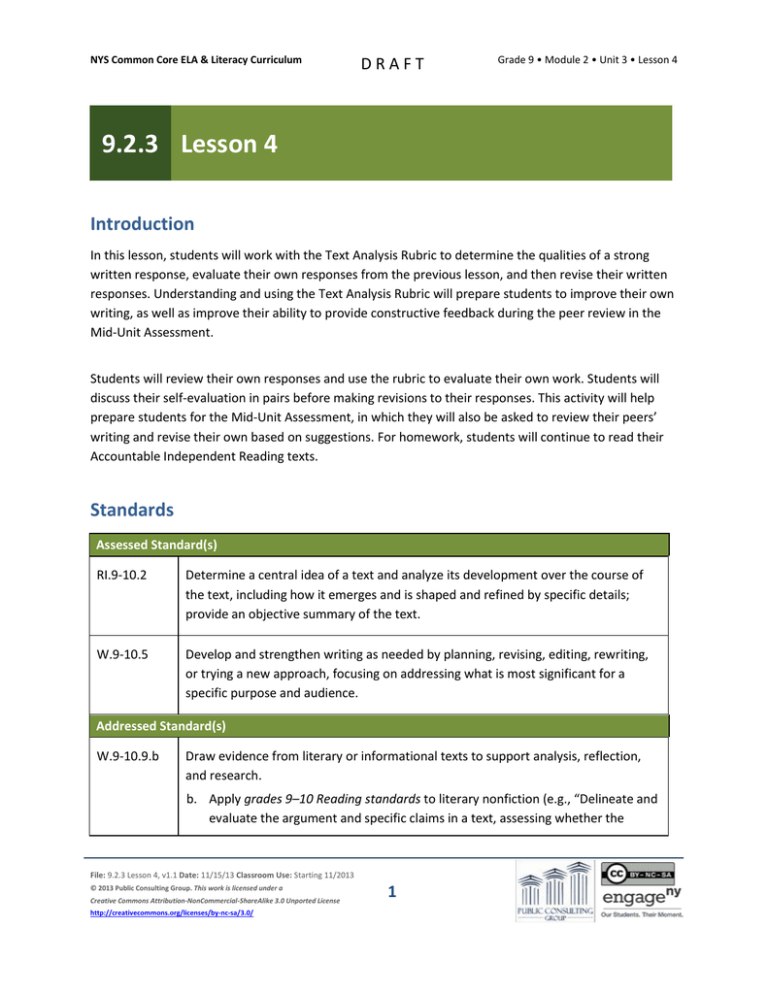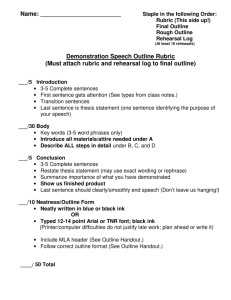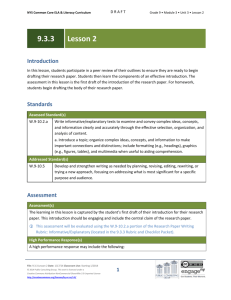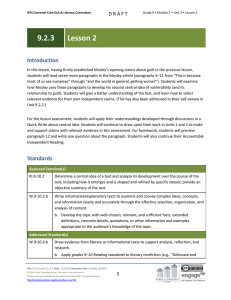Learning Sequence
advertisement

NYS Common Core ELA & Literacy Curriculum DRAFT Grade 9 • Module 2 • Unit 3 • Lesson 4 9.2.3 Lesson 4 Introduction In this lesson, students will work with the Text Analysis Rubric to determine the qualities of a strong written response, evaluate their own responses from the previous lesson, and then revise their written responses. Understanding and using the Text Analysis Rubric will prepare students to improve their own writing, as well as improve their ability to provide constructive feedback during the peer review in the Mid-Unit Assessment. Students will review their own responses and use the rubric to evaluate their own work. Students will discuss their self-evaluation in pairs before making revisions to their responses. This activity will help prepare students for the Mid-Unit Assessment, in which they will also be asked to review their peers’ writing and revise their own based on suggestions. For homework, students will continue to read their Accountable Independent Reading texts. Standards Assessed Standard(s) RI.9-10.2 Determine a central idea of a text and analyze its development over the course of the text, including how it emerges and is shaped and refined by specific details; provide an objective summary of the text. W.9-10.5 Develop and strengthen writing as needed by planning, revising, editing, rewriting, or trying a new approach, focusing on addressing what is most significant for a specific purpose and audience. Addressed Standard(s) W.9-10.9.b Draw evidence from literary or informational texts to support analysis, reflection, and research. b. Apply grades 9–10 Reading standards to literary nonfiction (e.g., “Delineate and evaluate the argument and specific claims in a text, assessing whether the File: 9.2.3 Lesson 4, v1.1 Date: 11/15/13 Classroom Use: Starting 11/2013 © 2013 Public Consulting Group. This work is licensed under a Creative Commons Attribution-NonCommercial-ShareAlike 3.0 Unported License http://creativecommons.org/licenses/by-nc-sa/3.0/ 1 NYS Common Core ELA & Literacy Curriculum DRAFT Grade 9 • Module 2 • Unit 3 • Lesson 4 reasoning is valid and the evidence is relevant and sufficient; identify false statements and fallacious reasoning”). Assessment Assessment(s) The learning in this lesson will be captured through students’ revised response to the previous lesson’s prompt: How do particular sentences in the text develop and refine Mosley's claim that “fiction…can offer escape” from our guilt and vulnerability? After working through the Text Analysis Rubric, students will review and improve their own analysis of how Mosley’s claim is developed and refined by specific details in the text. They will use the Text Analysis Rubric to develop and strengthen their writing as needed by revising, editing, rewriting, or trying a new approach. High Performance Response(s) A High Performance Response may vary, depending on the degree to which the first draft of the writing addressed the demands of the prompt and the degree to which the writing was revised as a result of the self-evaluation. Vocabulary Vocabulary to provide directly (will not include extended instruction) None.* Vocabulary to teach (may include direct word work and/or questions) None.* *Because this is not a close reading lesson, there is no specified vocabulary. However, in the process of returning to the text, students may uncover unfamiliar words. Teachers can guide students to make File: 9.2.3 Lesson 4, v1.1 Date: 11/15/13 Classroom Use: Starting 11/2013 © 2013 Public Consulting Group. This work is licensed under a Creative Commons Attribution-NonCommercial-ShareAlike 3.0 Unported License http://creativecommons.org/licenses/by-nc-sa/3.0/ 2 NYS Common Core ELA & Literacy Curriculum DRAFT Grade 9 • Module 2 • Unit 3 • Lesson 4 meaning of these words by following the protocols described in 1E of this document http://www.engageny.org/sites/default/files/resource/attachments/9-12_ela_prefatory_material.pdf. Lesson Agenda/Overview Student-Facing Agenda % of Lesson Standards & Text Standards: RI.9-10.2, W.9-10.5, W.9-10.9.b Text: “True Crime,” entire text Learning Sequence 1. 2. 3. 4. 5. 6. 1. 2. 3. 4. 5. 6. Introduction to Lesson Agenda Homework Accountability Rubric Introduction Self-Review Revision Closing 5% 10% 35% 15% 30% 5% Materials Copies of the Text Analysis Rubric: Peer Review Tool (Criterion 1 and 2) for each student Student copies of the 9.2 Common Core Learning Standards Tool (refer to 9.2.1 Lesson 1) Learning Sequence How to Use the Learning Sequence Symbol 10% Type of Text & Interpretation of the Symbol Percentage indicates the percentage of lesson time each activity should take. Plain text (no symbol) indicates teacher action. Bold text (no symbol) indicates questions for the teacher to ask students. Italicized text (no symbol) indicates a vocabulary word. Indicates student action(s). Indicates possible student response(s) to teacher questions. Indicates instructional notes for the teacher. File: 9.2.3 Lesson 4, v1.1 Date: 11/15/13 Classroom Use: Starting 11/2013 © 2013 Public Consulting Group. This work is licensed under a Creative Commons Attribution-NonCommercial-ShareAlike 3.0 Unported License http://creativecommons.org/licenses/by-nc-sa/3.0/ 3 NYS Common Core ELA & Literacy Curriculum DRAFT Grade 9 • Module 2 • Unit 3 • Lesson 4 Activity 1: Introduction to Lesson Agenda 5% Begin by reviewing the agenda and sharing the assessed standards for this lesson: RI.9-10.2, W.9-10.5. Inform students that they will revise and rewrite their assessment response from the previous lesson. Explain to students that this exercise will prepare them for the Mid-Unit Assessment’s peer review and revision components. Students look at the agenda. Activity 2: Homework Accountability 10% Lead a brief discussion on the previous lesson’s homework assignment: Mosley writes, “We are fascinated with stories of crime, real or imagined.” Think about how this claim relates to either “The Tell-Tale Heart” or Oedipus the King and write a paragraph explaining the connection. Direct students to discuss their answers in pairs. Students share their responses to the homework prompt from lesson 3. Inform students they should continue to think about the connections between the texts in the module and that they should begin to make note of the connections they are discovering. Activity 3: Rubric Introduction 35% Distribute copies of the Text Analysis Rubric: Peer Review Tool. Explain to students they will be working with the rubric in this lesson and during the Mid-Unit Assessment to improve their writing. Remind students that they have already engaged with the revision process in the previous unit and they will be building on the W.9-10.5 skills they have already learned. Students listen. Read the Content and Analysis criterion from the rubric aloud to students: “The extent to which the response conveys complex ideas and information clearly and accurately in order to respond to the task and support an analysis of the text.” Explain to students that this means the written responses should be clear and make sense to the reader; complicated ideas should come across easily in their writing. Instruct students to get into pairs and read and paraphrase the characteristics of a Level 4 response for the Content and Analysis criterion. File: 9.2.3 Lesson 4, v1.1 Date: 11/15/13 Classroom Use: Starting 11/2013 © 2013 Public Consulting Group. This work is licensed under a Creative Commons Attribution-NonCommercial-ShareAlike 3.0 Unported License http://creativecommons.org/licenses/by-nc-sa/3.0/ 4 NYS Common Core ELA & Literacy Curriculum DRAFT Grade 9 • Module 2 • Unit 3 • Lesson 4 Student responses may include: A Level 4 response would introduce an idea and explain it to the reader in an organized, clear way. It would also continually relate the text’s details back to the central idea, analyzing the development of that idea over the course of the text. Direct students to look at the rubric again. Ask students: What would cause the score of writing to go down to a Level 2 response, according to this rubric? A Level 2 response would introduce a claim, but it might not be well-reasoned. The analysis in the writing would be “superficial” and “literal.” Direct students to look at the second section of the Text Analysis Rubric: Peer Review Tool (Criterion 2). Read aloud the criterion for this section: “The extent to which the response presents evidence from the provided text to support analysis.” Instruct students to read through the characteristics of a Level 4 response according to this criterion. Ask students: What would be the characteristics of a Level 4 response according to this rubric? A Level 4 response would use a lot of direct evidence from the text to support a strong and clear analysis. How does the use of specific details in a response relate to demonstrating a thoughtful analysis? Using specific details demonstrates that the writer has worked closely with the text; thoughtful analysis requires close attention to details within the text. Explain to students that the use of specific details from the analyzed text demonstrates that the writer knows the text very well. Using evidence from the text to support analysis strengthens the writing. Ask students: What would cause the score of writing to go down to a Level 2 response, according to this rubric? A Level 2 response would use the wrong evidence to support an idea, or it would make few references to details in the text. Remind students of the homework prompt: Mosley writes, “We are fascinated with stories of crime, real or imagined.” Think about how this claim relates to either ”The Tell-Tale Heart” or Oedipus the King and write a paragraph explaining the connection. Present this response to the prompt: “The Tell-Tale Heart” connects to Mosley. It supports Mosley’s claim about fascination of crime. This story and point of view makes us see the mind of a bad guy. Also, this point of view also File: 9.2.3 Lesson 4, v1.1 Date: 11/15/13 Classroom Use: Starting 11/2013 © 2013 Public Consulting Group. This work is licensed under a Creative Commons Attribution-NonCommercial-ShareAlike 3.0 Unported License http://creativecommons.org/licenses/by-nc-sa/3.0/ 5 NYS Common Core ELA & Literacy Curriculum DRAFT Grade 9 • Module 2 • Unit 3 • Lesson 4 connects to the idea by Mosley that we need “someone to blame.” It makes us feel like we are better than the main character in “The Tell-Tale Heart.” Instruct students to read this response in pairs. Ask students: What score do you think this response deserves for both criteria? This receives a score of “1” for both criteria, because it disorganized, unclear, and does not provide enough specific details. It also does not show a thoughtful analysis. According to the rubric, what would make this response better? Provide an example of how you would re-write the first sentence. The writer could introduce more evidence to support the idea that “The Tell-Tale Heart” lets us see into the mind of a criminal, and also use a quote from Mosley to connect this idea back to Mosley’s claim that “we are fascinated by stories of crime, real or imagined.” The writer also needs to make sure their writing is clearer. For example, the first sentence could become: The point of view in “The Tell-Tale Heart” supports Mosley’s claim that “we are fascinated by stories of crime, real or imagined.” Remind students that as reviewers, it is important to offer advice in a helpful and kind way. Explain that criticizing someone’s work is not the same as reviewing and offering feedback for revision. It is important to feel safe during the revision process, and to have an open dialogue about the strengths of a work, and how to make it stronger. Activity 4: Self-Review 15% Hand back student responses to the assessment from the previous lesson. Explain that students will be using the Text Analysis Rubric: Peer Review Tool to evaluate their own responses. Instruct students to independently review their responses. Instruct students not to mark on their writing, but to make all their comments on the rubric itself. Students independently use the Text Analysis Rubric: Peer Review Tool to evaluate their response. File: 9.2.3 Lesson 4, v1.1 Date: 11/15/13 Classroom Use: Starting 11/2013 © 2013 Public Consulting Group. This work is licensed under a Creative Commons Attribution-NonCommercial-ShareAlike 3.0 Unported License http://creativecommons.org/licenses/by-nc-sa/3.0/ 6 NYS Common Core ELA & Literacy Curriculum DRAFT Grade 9 • Module 2 • Unit 3 • Lesson 4 Activity 5: Revision 30% Once students have finished reviewing their work using the rubric, instruct them to get back into pairs and briefly take turns explaining their self-reviews to each other. Instruct students to explain their rationale for their rubric scoring before starting to revise their writing. Students get into pairs and discuss their self-reviews. Once students have finished with this brief exchange, instruct them to begin revising their own writing independently. Students should strengthen their response as needed by revising, editing, rewriting, or trying a new approach, based on self-evaluation from the Text Analysis Rubric: Peer Review Tool. Remind students that writing is done for different purposes, but it is always important to take any opportunity to polish and strengthen written work. Inform students you will be reviewing their revised responses. Remind students to return to the text “True Crime” during the revision process to strengthen their responses (e.g., finding the most relevant evidence or using more specific details). If classroom or school computers are accessible, using Review features such as Track Changes and Comments in Microsoft Word will be useful for students, to address the demands of standard W.910.6: Use technology, including the Internet, to produce, publish, and update individual or shared writing products, taking advantage of technology’s capacity to link to other information and to display information flexibly and dynamically. Students independently revise their responses and hand them in at the end of class. Activity 6: Closing 5% Display and distribute the homework assignment. For homework, instruct students to continue their Accountable Independent Reading through the lens of their focus standard and prepare for a 3–5 minute discussion of their text based on that standard. Students follow along. Homework Continue to read your Accountable Independent Reading text through the lens of a focus standard of your choice and prepare for a 3–5 minute discussion of your text based on that standard. File: 9.2.3 Lesson 4, v1.1 Date: 11/15/13 Classroom Use: Starting 11/2013 © 2013 Public Consulting Group. This work is licensed under a Creative Commons Attribution-NonCommercial-ShareAlike 3.0 Unported License http://creativecommons.org/licenses/by-nc-sa/3.0/ 7 NYS Common Core ELA & Literacy Curriculum DRAFT Grade 9 • Module 2 • Unit 3 • Lesson 4 Model Text Analysis Rubric: Peer Review Tool Model Response (from 9.2.3 Lesson 3): Mosley introduces the claim that “fiction…can offer escape” by stating that through “crime shows, mysteries, and films” we can alleviate our feelings of guilt and vulnerability. Mosley believes that fiction connects to our feeling of fear as well. Someone in fiction cares if an innocent bystander gets hurt. The figures who care about how vulnerable we are in these fictional accounts are “heroes who can’t let us down.” Mosley further refines this claim by stating that we can be “saved” through our escape through fiction as well as be “forgiven” for the “sinful desires” that feed our guilt. Mosley says, “We need forgiveness and someone to blame,” and fiction offers us both. File: 9.2.3 Lesson 4, v1.1 Date: 11/15/13 Classroom Use: Starting 11/2013 © 2013 Public Consulting Group. This work is licensed under a Creative Commons Attribution-NonCommercial-ShareAlike 3.0 Unported License http://creativecommons.org/licenses/by-nc-sa/3.0/ 8 NYS Common Core ELA & Literacy Curriculum Grade 9 • Module 2 • Unit 3 • Lesson 4 DRAFT Model Text Analysis Rubric: Peer Review Tool (Criterion 1) Criteria 4 – Responses at this Level: 3 – Responses at this Level: 2 – Responses at this Level: 1 – Responses at this Level: Selected Score level (choose one based on the description of the student work) Content and Analysis: The extent to which the response conveys complex ideas and information clearly and accurately in order to respond to the task and support an analysis of the text. (W.9-10.2, W.9-10.9, RI.9-10.2, RI.9-10.5) Introduce a well-reasoned claim regarding the development of a central idea. Introduce a clear and focused claim regarding the development of a central idea. Introduce a claim regarding the development of a central idea. Introduce a confused or incomplete claim. Demonstrate a thoughtful analysis of the author’s use of specific details to shape and refine the central idea. Demonstrate an appropriate analysis of the author’s use of specific details to shape and refine the central idea. Demonstrate a superficial and/or mostly literal analysis of the author’s use of specific details to shape and refine the central idea. Demonstrate a minimal analysis of the author’s use of details to shape and refine the central idea. and/or and/or and/or and/or Demonstrate a thoughtful analysis of how the structure of texts, including how specific sentences, paragraphs, and larger portions of the text relate to each other and the whole. Demonstrate an appropriate analysis of how the structure of texts, including how specific sentences, paragraphs, and larger portions of the text relate to each other and the whole. Demonstrate a superficial and/or mostly literal analysis of how the structure of texts, including how specific sentences, paragraphs, and larger portions of the text relate to each other and the whole. Demonstrate a minimal analysis of how the structure of texts, including how specific sentences, paragraphs, and larger portions of the text relate to each other and the whole. and/or Evidence for score (2–3 sentences describing rationale for score level given) In this response the claim is introduced clearly and in precise detail. The response is focused around the central idea, but there could be more reasoning regarding the development of the idea in the text. This response demonstrates an appropriate analysis but could use more specific details. Summary of observations and specific suggestions for improvement in this criterion (4–7 sentences summarizing strengths and weaknesses of writing and how the student can make improvements to the student work.) Overall this is a strong response that analyzes the claim Mosley is making about fiction in the text. There is some work that can be done around the idea of why Mosley says we connect with fiction. The feeling of fear is present, but the writer addresses it only superficially and could do a better job connecting it to the central ideas of guilt and vulnerability. To improve this response, consider how guilt and vulnerability contribute to our interest in fiction and also connect that interest to more sections of the article (e.g., why Mosley says we feel guilty in the first place). File: 9.2.3 Lesson 4, v1.1 Date: 11/15/13 Classroom Use: Starting 11/2013 © 2013 Public Consulting Group. This work is licensed under a Creative Commons Attribution-NonCommercial-ShareAlike 3.0 Unported License http://creativecommons.org/licenses/by-nc-sa/3.0/ 9 NYS Common Core ELA & Literacy Curriculum DRAFT Grade 9 • Module 2 • Unit 3 • Lesson 4 Model Text Analysis Rubric: Peer Review Tool (Criterion 2) Criteria 4 – Responses at this Level: 3 – Responses at this Level: 2 – Responses at this Level: 1 – Responses at this Level: Present ideas inconsistently, inadequately, and/or inaccurately in an attempt to support analysis, making use of some evidence that may be irrelevant. Present little or no evidence from the text. Selected Score level (choose one based on the description of the student work) Command of Evidence: The extent to which the response presents evidence from the provided text to support analysis. Present ideas clearly and consistently, making effective use of specific and relevant evidence to support analysis. Present ideas sufficiently, making adequate use of relevant evidence to support analysis. (W.9-10.2.a, W.9-10.9) Evidence for score (2–3 sentences describing rationale for score level given) This response presents ideas clearly, and the author repeatedly refers back to the text to support his claims. The response quotes the Mosley text often, using specific words and sentences from “True Crime” to support analysis. Still, the author could explain the quotes more. Summary of observations and specific suggestions for improvement in this criterion (4–7 sentences summarizing strengths and weaknesses of writing and how the student can make improvements to the student work.) The author could provide more explanation about how the textual references connect to the claim. For instance, the author could expand on or provide a specific example of how fictional “heroes” care about “how vulnerable we are.” File: 9.2.3 Lesson 4, v1.1 Date: 11/15/13 Classroom Use: Starting 11/2013 © 2013 Public Consulting Group. This work is licensed under a Creative Commons Attribution-NonCommercial-ShareAlike 3.0 Unported License http://creativecommons.org/licenses/by-nc-sa/3.0/ 10 NYS Common Core ELA & Literacy Curriculum Grade 9 • Module 2 • Unit 3 • Lesson 4 DRAFT Text Analysis Rubric: Peer Review Tool (Criterion 1) Criteria 4 – Responses at this Level: 3 – Responses at this Level: 2 – Responses at this Level: 1 – Responses at this Level: Selected Score level (choose one based on the description of the student work) Content and Analysis: The extent to which the response conveys complex ideas and information clearly and accurately in order to respond to the task and support an analysis of the text. (W.9-10.2, W.9-10.9, RI.9-10.2, RI.9-10.5) Introduce a well-reasoned claim regarding the development of a central idea. Introduce a clear and focused claim regarding the development of a central idea. Introduce a claim regarding the development of a central idea. Demonstrate a thoughtful analysis of the author’s use of specific details to shape and refine the central idea. Demonstrate an appropriate analysis of the author’s use of specific details to shape and refine the central idea. Demonstrate a superficial and/or mostly literal analysis of the author’s use of specific details to shape and refine the central idea. Demonstrate a minimal analysis of the author’s use of details to shape and refine the central idea. and/or and/or and/or and/or Demonstrate a thoughtful analysis of how the structure of texts, including how specific sentences, paragraphs, and larger portions of the text relate to each other and the whole. Demonstrate an appropriate analysis of how the structure of texts, including how specific sentences, paragraphs, and larger portions of the text relate to each other and the whole. Demonstrate a superficial and/or mostly literal analysis of how the structure of texts, including how specific sentences, paragraphs, and larger portions of the text relate to each other and the whole. Demonstrate a minimal analysis of how the structure of texts, including how specific sentences, paragraphs, and larger portions of the text relate to each other and the whole. Evidence for score (2–3 sentences describing rationale for score level given) Summary of observations and specific suggestions for improvement in this criterion (4–7 sentences summarizing strengths and weaknesses of writing and how the student can make improvements to the student work.) File: 9.2.3 Lesson 4, v1.1 Date: 11/15/13 Classroom Use: Starting 11/2013 © 2013 Public Consulting Group. This work is licensed under a Creative Commons Attribution-NonCommercial-ShareAlike 3.0 Unported License http://creativecommons.org/licenses/by-nc-sa/3.0/ 11 Introduce a confused or incomplete claim. and/or NYS Common Core ELA & Literacy Curriculum DRAFT Grade 9 • Module 2 • Unit 3 • Lesson 4 Text Analysis Rubric: Peer Review Tool (Criterion 2) Criteria 4 – Responses at this Level: 3 – Responses at this Level: 2 – Responses at this Level: 1 – Responses at this Level: Present ideas inconsistently, inadequately, and/or inaccurately in an attempt to support analysis, making use of some evidence that may be irrelevant. Present little or no evidence from the text. Selected Score level (choose one based on the description of the student work) Command of Evidence: The extent to which the response presents evidence from the provided text to support analysis. Present ideas clearly and consistently, making effective use of specific and relevant evidence to support analysis. Present ideas sufficiently, making adequate use of relevant evidence to support analysis. (W.9-10.2.a, W.9-10.9) Evidence for score (2–3 sentences describing rationale for score level given) Summary of observations and specific suggestions for improvement in this criterion (4–7 sentences summarizing strengths and weaknesses of writing and how the student can make improvements to the student work.) File: 9.2.3 Lesson 4, v1.1 Date: 11/15/13 Classroom Use: Starting 11/2013 © 2013 Public Consulting Group. This work is licensed under a Creative Commons Attribution-NonCommercial-ShareAlike 3.0 Unported License http://creativecommons.org/licenses/by-nc-sa/3.0/ 12




